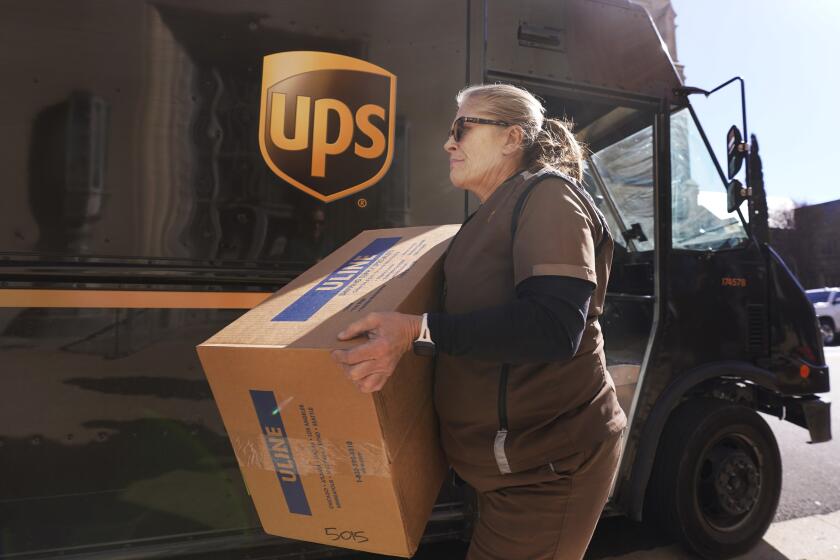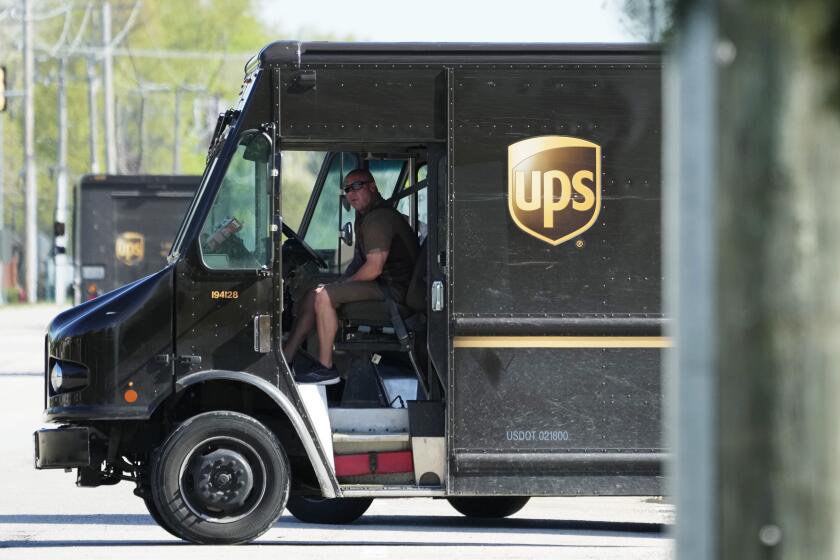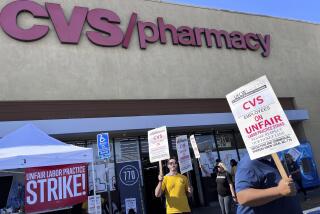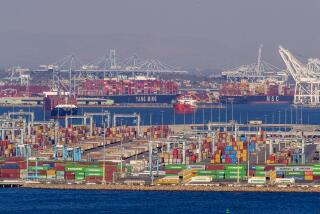UPS reaches tentative contract with 340,000 unionized workers, potentially dodging calamitous strike

- Share via
UPS has reached a contract agreement with its 340,000-member union, averting a strike that had the potential to disrupt logistics nationwide for businesses and households alike.
The agreement was announced Tuesday, the first day that UPS and the Teamsters had returned to the table after negotiations broke down this month to talk over remaining sticking points in the largest private-sector contract in North America. Negotiators had clashed over pay for part-time workers who make up more than half of the UPS employees represented by the union.
The Teamsters called the tentative agreement “historic.”
Under the agreement, existing full- and part-time union workers will get $2.75 more per hour in 2023 and $7.50 more per hour over the length of the five-year contract. The agreement also includes a provision to increase starting pay for part-time workers, which the union had called the most at risk in the company’s workforce of being exploited. Starting pay for part-time workers will be $21 per hour, it said, up from $16.20 today. The average pay for part-timers had been $20, according to the company.
Teamsters General President Sean M. O’Brien said UPS put $30 billion in new money on the table as a result of the negotiations.
“This contract sets a new standard in the labor movement and raises the bar for all workers,” he said in a statement.
More than 300,000 United Parcel Service workers are closer to striking after the company failed to reach an agreement with the International Brotherhood of Teamsters.
The two sides had agreed tentatively on making Martin Luther King Jr. Day a full holiday and ending forced overtime on drivers’ days off. Tentative agreements on safety issues had also been reached, including equipping more trucks with air conditioning.
UPS had also agreed to eliminate a lower-paid category of drivers who work shifts that include weekends, and convert them into regular full-time drivers. The company will also create 7,500 full-time jobs and fill 22,500 open positions, which could allow more part-timers to transition to full-time work.
“Together we reached a win-win-win agreement on the issues that are important to Teamsters leadership, our employees and to UPS and our customers,” Carol Tomé, UPS chief executive, said in a statement. “This agreement continues to reward UPS’s full- and part-time employees with industry-leading pay and benefits while retaining the flexibility we need to stay competitive, serve our customers and keep our business strong.”
Voting on the new contract begins Aug. 3 and concludes Aug. 22.
In Washington, President Biden applauded the two sides for reaching a deal.
“This agreement is a testament to the power of employers and employees coming together to work out their differences at the bargaining table in a manner that helps businesses succeed while helping workers secure pay and benefits they can raise a family on and retire with dignity and respect,” Biden said in a statement.
Unionized UPS workers have voted overwhelmingly to authorize a strike, setting the stage for a potential work stoppage if an agreement can’t be reached.
Union members, angered by a contract they say was forced on them five years ago by union leadership, clashed with UPS over pay as profits for the delivery company soared in recent years. Union leadership was upended last year with the election of Sean O’Brien, a vocal critic of his predecessor, James Hoffa, the son of the famous Teamsters firebrand Jimmy Hoffa.
Profits at UPS have grown more than 140% since the last contract was signed as the arrival of a deadly pandemic drastically transformed the manner in which Americans get what they need.
Unionized workers argued that they were the ones shouldering growth at the Atlanta company and appeared dead set on righting what they saw as a bad contract.
The 24 million packages UPS ships on an average day amounts to about a quarter of all U.S. parcel volume, according to global shipping and logistics firm Pitney Bowes. As UPS puts it, that’s the equivalent of about 6% of nation’s gross domestic product.
The last breakdown in labor talks a quarter-century ago led to a 15-day walkout by 185,000 UPS workers that crippled the company. A walkout would have had far-reaching implications this time around, with millions of Americans now accustomed to online shopping and speedy delivery.
SAG-AFTRA has approved a deal from the studios to end its historic strike. The actors were on strike for more than 100 days.
Consulting firm Anderson Economic Group said a 10-day UPS strike could have cost the U.S. economy more than $7 billion and triggered “significant and lasting harm” to small businesses, household workers and online retailers across the country.
Logistics experts had warned that all of the other shipping companies combined would not have had the capacity to handle the packages that would flow their way during any UPS work stoppage, and prices on shipping and goods would eventually increase. Customers who shop online could have faced more shipping fees and longer waits.
In recent weeks, large and small businesses worked to create contingency plans in the event of a UPS strike.
Joseph Debicella, a small-business owner who runs an online site that sells bridesmaid gifts, said his company ships roughly 50% of its orders through UPS. He hasn’t used FedEx before but created an account with the company two weeks ago as chatter over a strike picked up. He was also hearing about the negotiations from his UPS driver, who told him his deliveries were getting lighter as the July 31 deadline for a new contract neared.
Debicella, who lives in Charlotte, N.C., says he’s been concerned about costs because he provides free shipping to customers who spend more than $99 on the site.
The constantly shifting nature of the hotel strike action can make it difficult to keep track of what’s going on. Here’s what you need to know.
Macy’s CEO Jeff Gennette said that the department store chain was looking at contingency plans in case of a strike and that its supply chain team was mapping out what a strike would look like and how it would affect shipping.
The deal could prevent a major logistics disruption just as retailers were in the throes of the back-to-school shopping season, the second-largest sales period behind the winter holidays.
The Retail Industry Leaders Assn., a national trade group that counts retailers such as Best Buy, CVS Health and Kohl’s as members, called the tentative pact “an enormous relief to retailers, who have been navigating the possibility of a strike and the associated uncertainty for weeks.”
“We’ve learned all too well over the last several years the impact supply chain disruptions can have,” the group said in a statement. ”We’re grateful that this challenge, which would have had a price tag in the billions of dollars and a long runway for recovery, was avoided.”
Labor experts see the showdown as a demonstration of labor power at a time of low union membership in the U.S. Unions, however, have grown active this summer after a number of organized labor pushes at major companies including Starbucks.
Hollywood actors and screenwriters are picketing over pay issues. United Auto Workers are also talking about a potential strike.
“This is how it’s done!” Assn. of Flight Attendants-CWA President Sara Nelson said in a statement congratulating the Teamsters for the deal. “And this labor solidarity summer just got stronger.”
AP writers Matt Ott and Anne D’Innocenzio contributed to this report.
More to Read
Inside the business of entertainment
The Wide Shot brings you news, analysis and insights on everything from streaming wars to production — and what it all means for the future.
You may occasionally receive promotional content from the Los Angeles Times.














